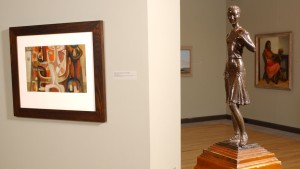Please join us as we post information about pieces in the Marianna Kistler Beach Museum of Art’s permanent collection from …to build up a rich collection… Selected works from The Marianna Kistler Beach Museum of Art.
All pieces in this series are on display now at the museum. We hope you will join in the discussion and enjoy learning in-depth about the heart of the museum, our permanent collection. This post will focus on a bronze sculpture by Bruce Moore, College Womanhood.
So, what does this piece make you wonder?

Best known as a sculptor of animals, Bruce Moore was born in Bern, Kansas, and spent most of his early childhood in Pratt, Kansas. In 1917, at the age of twelve, Moore and his family moved to Wichita. In his teen years Moore demonstrated a great deal of promise as a sculptor, attracting the attention and support of some of the most prominent figures in the Wichita’s art community, including artists Edmund Davison (Plate 3) and C. A. Seward, and arts patron Maude Schollenberger. In 1922 Moore enrolled in the Pennsylvania Academy of Fine Arts, where he studied with Charles Grafly, the noted American sculptor. As a student he developed what would become a deep and lasting friendship with Grafly, who continued to support and advise Moore throughout his career. Following his graduations from the Academy in 1926, Moore returned to Wichita to teach at Fairmount College (now Wichita State University) and at the School of Wichita Art Association. In 1929 Moore left Wichita for two years of study in Paris on a Guggenheim Fellowship. Moore retuned to Wichita in 1931, where he lived and taught in New York City in 1933. While in Paris Moore’s natural style began to shift from Art Deco aesthetic toward a style characterized by an increasing naturalism. College Womanhood, created the year after Moore returned from Paris, is an early example of this development.
In 1932 the K-State Woman’s Pan-Hellenic Council commissioned Moore to create a permanent college trophy for the school’s sororities. College Womanhood is the result of that commission. According to a 1932 article appearing in the Kansas Industrialist, one of the school’s newspapers Moore was charged with designing:
. . .a small bronze about 19 inched or more in height which will signify, or typify, the ideals of college womanhood. Not only should scholarship be emphasized, but other traits that are equally desirable. These include interest in school, service to others, and the more physical side-such as an interest in athletics.
Described by on reviewer as “a spirited bronze, the torso womanly and yet as slim and energetic as the body of youth,” the figure of College Womanhood is a composite of two K-State sorority women whom Moore used as models. According to the Kansas City Star, the young women “were popular, athletic, and had made good grades.” Confidently posed in contemporary dress Moore’s figure is decidedly modern in type. With cocked hip and pronounced pudendum, she exudes an awareness and command of her budding sexuality. She is clearly comfortable with her womanhood, cognizant of its power, allure, and the responsibility it represents. Moore’s inclusion of a prickly pear cactus on the ground behind her right foot underscores this notion. The sweet and juicy fruit of the prickly pear, a succulent notable for its beautiful blossoms, is clad with sharp, menacing spines, poised to prick those who approach without exercising the proper respect. Moore’s treatment of the figure’s clothing and the sandals in which she is shod is clearly a reference to ancient Greek art and culture, particularly his use of wet drapery to reveal the figure’s form beneath her garments, a stylistic device found in ancient Greek sculpture of the Hellenistic period (330-146 B.C.).
For a number of years, the sculpture was displayed in the K-State Library. Each year, the name of the sorority with the highest grade point average was engraved on a plaque mounted on the sculpture’s walnut base, which was built in the K-State woodshop. Pi Beta Phi was the first sorority to be recognized on the plaque.
Learn more about the collection of the Beach Museum of Art on our searchable collection database.